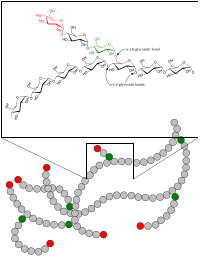
Photo from wikipedia
Abstract Glycerol is a well-tolerated additive in aquafeeds. We hypothesized that in seabass, a carnivorous fish whose endogenous carbohydrate demands are mostly met by hepatic amino acid gluconeogenesis, glycerol effectively… Click to show full abstract
Abstract Glycerol is a well-tolerated additive in aquafeeds. We hypothesized that in seabass, a carnivorous fish whose endogenous carbohydrate demands are mostly met by hepatic amino acid gluconeogenesis, glycerol effectively competes with these substrates for endogenous glucose and glycogen synthesis. To test this hypothesis, we injected fasted and fed juvenile seabass with an intraperitoneal 2 g.kg−1 bolus of glycerol enriched to 25% with [U-13C3]glycerol and monitored the appearance of blood glucose and hepatic glycogen 13C-isotopomers 48-h thereafter by 13C NMR spectroscopy. This information was used to determine the fractional contribution of the glycerol load to systemic glucose appearance and liver glycogen synthesis. In 21-day fasted fish, the glycerol bolus contributed 47 ± 3% of circulating glucose appearance and 40 ± 3% of hepatic glycogen at 48-h post-bolus. In fed fish, the glycerol bolus accounted for 17 ± 3% of circulating glucose and 3 ± 1% of hepatic glycogen at 48-h post-polus. While the majority of glycerol was metabolized to glucose and glycogen via the canonical linear gluconeogenic pathway, a significant minority was converted to glucose and glycogen via the hepatic Krebs cycle. In fasted fish, linear gluconeogenesis accounted for 40 ± 3% of glucose appearance while the Krebs cycle route accounted for 7 ± 2%. In fed fish, linear and Krebs cycle-mediated contributions were 10 ± 2% and 6 ± 2%, respectively. These data indicate that glycerol effectively competes with endogenous precursors for hepatic gluconeogenesis in carnivorous fish thereby representing a novel mechanism for reducing the catabolic utilization of amino acids.
Journal Title: Aquaculture
Year Published: 2019
Link to full text (if available)
Share on Social Media: Sign Up to like & get
recommendations!